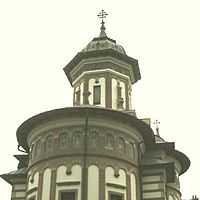Sinaia
| Sinaia | ||
|---|---|---|
 | ||
| ||
 | ||
| Coordinates: 45°21′0″N 25°33′5″E / 45.35000°N 25.55139°ECoordinates: 45°21′0″N 25°33′5″E / 45.35000°N 25.55139°E | ||
| Country |
| |
| County | Prahova County | |
| Status | Town | |
| Government | ||
| • Mayor | Vlad Gheorghe Oprea (National Liberal Party) | |
| Population (2011) | ||
| • Total | 10,410 | |
| Time zone | EET (UTC+2) | |
| • Summer (DST) | EEST (UTC+3) | |
| Website | http://www.primariasinaia.ro/ | |
Sinaia (Romanian pronunciation: [siˈnaja]) is a town and a mountain resort in Prahova County, Romania. The town was named after Sinaia Monastery, around which it was built; the monastery in turn is named after the Biblical Mount Sinai. King Carol I of Romania built his summer home, Peleș Castle, near the town.
Sinaia is about 60 kilometres (37 miles) northwest of Ploiești and 50 kilometres (31 miles) south of Brașov, in a mountainous area on the Prahova River valley, just east of the Bucegi Mountains. The altitude varies from 767 to 860 metres (2,516 to 2,822 feet) above sea level.
The city is a popular destination for hiking and winter sports, especially downhill skiing. Among the tourist landmarks, the most important are Peleș Castle, Pelișor Castle, Sinaia Monastery, Sinaia Casino, Sinaia train station, and the Franz Joseph and Saint Anne Cliffs. Sinaia was also the summer residence of the Romanian composer George Enescu, who stayed at the Luminiș villa.
| Historical population | ||
|---|---|---|
| Year | Pop. | ±% |
| 1912 | 3,919 | — |
| 1930 | 4,072 | +3.9% |
| 1948 | 6,537 | +60.5% |
| 1956 | 9,006 | +37.8% |
| 1966 | 11,976 | +33.0% |
| 1977 | 13,822 | +15.4% |
| 1992 | 15,465 | +11.9% |
| 2002 | 14,636 | −5.4% |
| 2011 | 10,410 | −28.9% |
| Source: Census data | ||
Climate

The climate is a characteristic of low-altitude mountain passes. Annual average temperature: 8 °C (46 °F) Average temperature in June: 15 °C (59 °F) Average temperature in January: −4 °C (25 °F).
Summers are bracing and very rainy in the beginning of the season. Winters are relatively mild, with heavy snow. Average annual rainfall is 900 millimetres (35.4 inches) The maximum monthly registered rainfall was in June (173 mm). The minimum rainfall was recorded in September 55 mm (2.2 in) and February 40 mm (1.6 in).
A uniform layer of snow is deposited usually in November and it melts from March to April, sometimes at the beginning of May. The thickness of the snow layer varies between 20 centimeters and 3 meters in higher elevations.
In recent years, Sinaia has felt the effects of global climate change – change that has meant shorter summers, with temperatures frequently over 30 °C (86 °F), a slight reduction in the length of spring and autumn, and relatively longer winters (end of October – beginning of May), colder winters with entire weeks dominated by frost −25 to −19 °C (−13 to −2 °F) and numerous blizzards.
Natural cure factors
Proponents claim that Sinaia has a refreshing and stimulating climate that is beneficial to the human body. There are also some mineral springs in Câinelui Valley that have sulphur-ferric mineral water and contain other soluble minerals.
Nature preservation

In the town of Sinaia and its surroundings restrictions are in place regarding cutting down or picking up flora. The felling of trees is not allowed. It is forbidden to pick up any alpine plants. Severe punishment may be in store for those who gather these plants: the Mountain Peony (Rhododendron Kotsky), Edelweiss (Leontopodium alpinum), and the Yellow Gentiana (Gentiana lutea). Tourist camping is only authorized in designated places, following necessary and compulsory protection standards.
The mountainous area in which Sinaia is located is in the Bucegi Natural Park region. The Park covers a total area of 326.63 square kilometres (126.11 sq mi), of which 58.05 km2 (22.41 sq mi) are under strict protection and shelter natural monuments. The Bucegi Natural Preserve area includes all the abrupt areas of the mountains Vârful cu Dor, Furnica, and Piatra Arsă. The mountainous area is continuously patrolled by mountain rescue patrols as well as by members of the Mountain Police.
At the entrance to the Cumpătu district, one can find the “Sinaia alder-tree grove” botanical reservation placed under the protection of the Romanian Academy and the Bucharest Biology Institute. In the same district, there is also another ecological research station under the patronage of UNESCO – Jacques-Yves Cousteau, belonging to the University of Bucharest, which also includes a museum of Bucegi Mountains fauna in a laboratory for nature protection.
International relations
Twin towns — Sister cities
Sinaia is twinned with:
Notable residents
- George Enescu
- Romanian Royal family
Gallery
-

The Sinaia City Hall
-

The Sinaia cable car
-

A steam engine exhibited in the railway station
-

3D animation for Sinaia
-

3D map for Sinaia
References
- ↑ Annuaire-Mairie.fr. "Ville d'Aoste" (in French). Retrieved 2013-06-18.
External links
| Wikimedia Commons has media related to Sinaia. |
 Sinaia travel guide from Wikivoyage
Sinaia travel guide from Wikivoyage
| |||||

